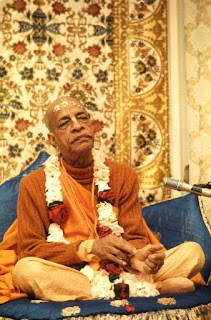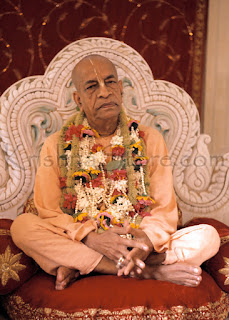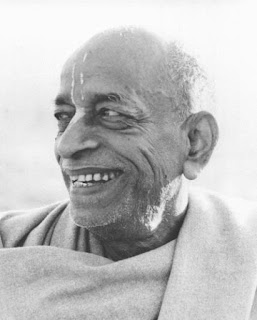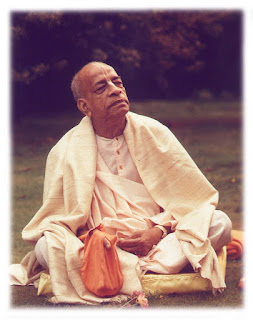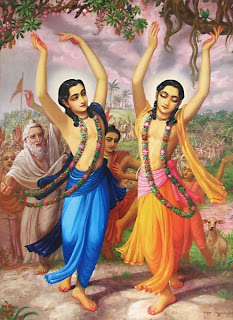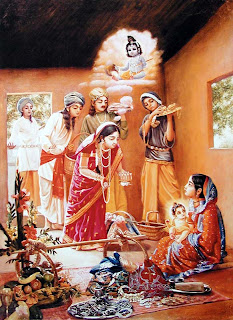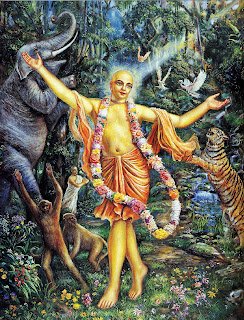Below is the brief summary of all eighteen chapters of Bhagavad Gita
Chapter One:
Observing the Armies on the Battlefield of Kurukshetra
As the opposing armies stand poised for battle, Arjuna, the
mighty warrior, sees his intimate relatives, teachers and friends in both
armies ready to fight and sacrifice their lives. Overcome by grief and pity,
Arjuna fails in strength, his mind becomes bewildered, and he gives up his
determination to fight.
Chapter Two: Contents of the Gita
summarized
Arjuna submits to Lord Krishna as His disciple, and Krishna
begins His teachings to Arjuna by explaining the fundamental distinction
between the temporary material body and the eternal spiritual soul. The Lord
explains the process of transmigration, the nature of selfless service to the
Supreme and the characteristics of a self-realized person.
Chapter Three: Karma-yoga
Everyone must engage in some sort of activity in this material
world. But actions can either bind one to this world or liberate one from it.
By acting for the pleasure of the Supreme, without selfish motives, one can be
liberated from the law of karma (action and reaction) and attain transcendental
knowledge of the self and the Supreme.
Chapter Four: Transcendental
knowledge
Transcendental knowledge – the spiritual knowledge of the soul,
of God, and of their relationship – is both purifying and liberating. Such
knowledge is the fruit of selfless devotional action (karma-yoga). The Lord
explains the remote history of the Gita, the purpose and significance of His
periodic descents to the material world, and the necessity of approaching a
guru, a realized teacher.
Chapter Five: Karma-yoga – Action in
Krishna Consciousness
Outwardly performing all actions but inwardly renouncing their
fruits, the wise man, purified by the fire of transcendental knowledge, attains
peace, detachment, forbearance, spiritual vision and bliss.
Chapter Six: Dhyana-yoga
Ashtanga-yoga, a mechanical meditative practice, controls the
mind and senses and focuses concentration on Paramatma (the Supersoul, the form
of the Lord situated in the heart). This practice culminates in samadhi, full
consciousness of the Supreme.
Chapter Seven: Knowledge of the
Absolute
Lord Krishna is the Supreme Truth, the supreme cause and
sustaining force of everything, both material and spiritual. Advanced souls
surrender unto Him in devotion, whereas impious souls divert their minds to
other objects of worship.
Chapter Eight: Attaining the Supreme
By remembering Lord Krishna in devotion throughout one’s life,
and especially at the time of death, one can attain to His supreme abode,
beyond the material world.
Chapter Nine: The most confidential
knowledge
Lord Krishna is the Supreme Godhead and the supreme object of
worship. The soul is eternally related to Him through transcendental devotional
service (bhakti). By reviving one’s pure devotion one returns to Krishna in the
spiritual realm.
Chapter Ten: The Opulence of the
Absolute
All wondrous phenomena showing power, beauty, grandeur or
sublimity, either in the material world or in the spiritual, are but partial
manifestations of Krishna’s divine energies and opulence. As the supreme cause
of all causes and the support and essence of everything, Krishna is the supreme
object of worship for all beings.
Chapter Eleven: The Universal Form
Lord Krishna grants Arjuna divine vision and reveals His
spectacular unlimited form as the cosmic universe. Thus He conclusively
establishes His divinity. Krishna explains that His own all-beautiful humanlike
form is the original form of Godhead. One can perceive this form only by pure
devotional service.
Chapter Twelve: Devotional Service
(Bhakti-yoga)
Bhakti-yoga, pure devotional service to Lord Krishna, is the
highest and most expedient means for attaining pure love for Krishna, which is
the highest end of spiritual existence. Those who follow this supreme path
develop divine qualities.
Chapter Thirteen: Nature, the Enjoyer and
Consciousness
One who understands the difference between the body, the soul
and the Supersoul beyond them both attains liberation from this material world.
Chapter Fourteen: The Three Modes of
Material Nature
All embodied souls are under the control of the three modes, or
qualities, of material nature: goodness, passion and ignorance. Lord Krishna
explains what these modes are, how they act upon us, how one transcends them,
and the symptoms of one who has attained the transcendental state.
Chapter Fifteen: The Yoga of the Supreme
Person
The ultimate purpose of Vedic knowledge is to detach oneself
from the entanglement of the material world and to understand Lord Krishna as
the Supreme Personality of Godhead. One who understands Krishna’s supreme
identity surrenders unto Him and engages in His devotional service.
Chapter Sixteen: The Divine and Demoniac
Natures
Those who possess demoniac qualities and who live whimsically,
without following the regulations of scripture, attain lower births and further
material bondage. But those who possess divine qualities and live regulated
lives, abiding by scriptural authority, gradually attain spiritual perfection.
Chapter Seventeen: The Divisions of Faith
There are three types of faith, corresponding to and evolving
from the three modes of material nature. Acts performed by those whose
faith is in passion and ignorance yield only impermanent, material results,
whereas acts performed in goodness, in accord with scriptural injunctions,
purify the heart and lead to pure faith in Lord Krishna and devotion to Him.
Chapter Eighteen: Conclusion – The
Perfection of Renunciation
Krishna explains the meaning of renunciation and the effects of
the modes of nature on human consciousness and activity. He explains Brahman
realization, the glories of the Bhagavad-gita, and the ultimate conclusion of
the Gita: the highest path of religion is absolute, unconditional loving
surrender unto Lord Krishna, which frees one from all sins, brings one to
complete enlightenment, and enables one to return to Krishna’s eternal
spiritual abode.
*** Hare Krishna ***



